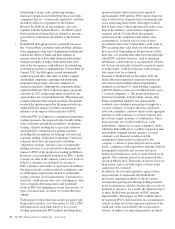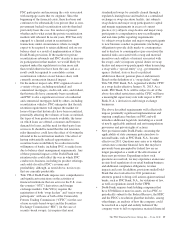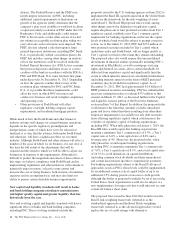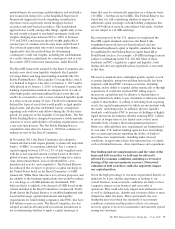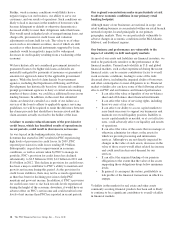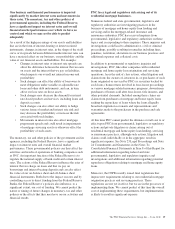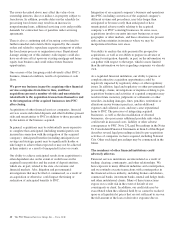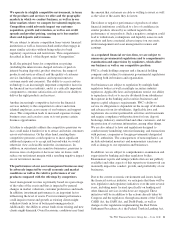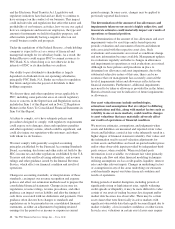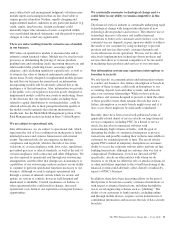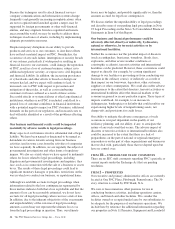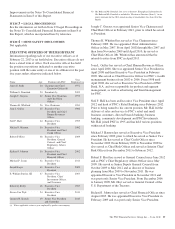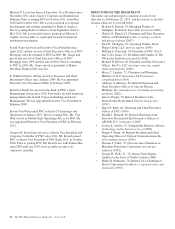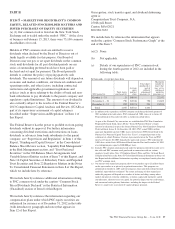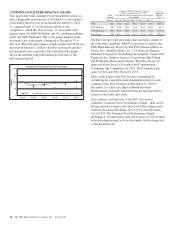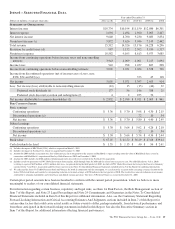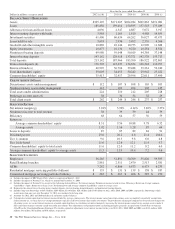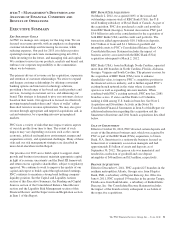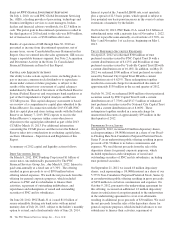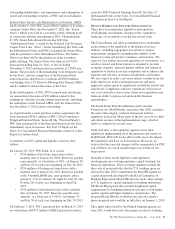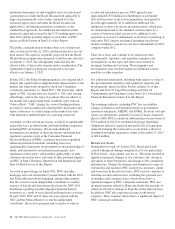PNC Bank 2012 Annual Report Download - page 43
Download and view the complete annual report
Please find page 43 of the 2012 PNC Bank annual report below. You can navigate through the pages in the report by either clicking on the pages listed below, or by using the keyword search tool below to find specific information within the annual report.Because the techniques used to attack financial services
company communications and information systems change
frequently (and generally increasing in sophistication), often
are not recognized until launched against a target, may be
supported by foreign governments or other well-financed
entities, and may originate from less regulated and remote
areas around the world, we may be unable to address these
techniques in advance of attacks, including by implementing
adequate preventative measures.
Despite temporary disruptions in our ability to provide
products and services to our customers, to date these efforts
have not had a material impact on PNC. Nonetheless, the
occurrence of any such failure, interruption or security breach
of our systems, particularly if widespread or resulting in
financial losses to our customers, could damage the reputation
of PNC, result in a loss of customer business, subject us to
additional regulatory scrutiny, or expose us to civil litigation
and financial liability. In addition, the increasing prevalence
of cyberattacks and other efforts to breach or disrupt our
systems has led, and we expect will continue to lead, to
increased costs to PNC with respect to prevention and
mitigation of these risks, as well as costs reimbursing
customers for losses suffered as a result of these actions.
Successful attacks or systems failures at other large financial
institutions, whether or not PNC is included, could lead to a
general loss of customer confidence in financial institutions
with a potential negative impact on PNC’s business, additional
demands on the part of our regulators, and increased costs to
deal with risks identified as a result of the problems affecting
others.
Our business and financial results could be impacted
materially by adverse results in legal proceedings.
Many aspects of our business involve substantial risk of legal
liability. We have been named or threatened to be named as
defendants in various lawsuits arising from our business
activities (and in some cases from the activities of companies
we have acquired). In addition, we are regularly the subject of
governmental investigations and other forms of regulatory
inquiry. We also are at risk when we have agreed to indemnify
others for losses related to legal proceedings, including
litigation and governmental investigations and inquiries, they
face, such as in connection with the sale of a business or assets
by us. The results of these legal proceedings could lead to
significant monetary damages or penalties, restrictions on the
way in which we conduct our business, or reputational harm.
Although we establish accruals for legal proceedings when
information related to the loss contingencies represented by
those matters indicates both that a loss is probable and that the
amount of loss can be reasonably estimated, we do not have
accruals for all legal proceedings where we face a risk of loss.
In addition, due to the inherent subjectivity of the assessments
and unpredictability of the outcome of legal proceedings,
amounts accrued may not represent the ultimate loss to us
from the legal proceedings in question. Thus, our ultimate
losses may be higher, and possibly significantly so, than the
amounts accrued for legal loss contingencies.
We discuss further the unpredictability of legal proceedings
and describe some of our pending legal proceedings in Note
23 Legal Proceedings in the Notes To Consolidated Financial
Statements in Item 8 of this Report.
Our business and financial performance could be
adversely affected, directly or indirectly, by disasters,
natural or otherwise, by terrorist activities or by
international hostilities.
Neither the occurrence nor the potential impact of disasters
(such as earthquakes, hurricanes, tornadoes, floods, fires,
explosions, and other severe weather conditions or
catastrophic accidents), terrorist activities and international
hostilities can be predicted. However, these occurrences could
impact us directly (for example, by causing significant
damage to our facilities or preventing us from conducting our
business in the ordinary course), or indirectly as a result of
their impact on our borrowers, depositors, other customers,
suppliers or other counterparties. We could also suffer adverse
consequences to the extent that disasters, terrorist activities or
international hostilities affect the financial markets or the
economy in general or in any particular region. These types of
impacts could lead, for example, to an increase in
delinquencies, bankruptcies or defaults that could result in our
experiencing higher levels of nonperforming assets, net
charge-offs and provisions for credit losses.
Our ability to mitigate the adverse consequences of such
occurrences is in part dependent on the quality of our
resiliency planning, and our ability, if any, to anticipate the
nature of any such event that occurs. The adverse impact of
disasters or terrorist activities or international hostilities also
could be increased to the extent that there is a lack of
preparedness on the part of national or regional emergency
responders or on the part of other organizations and businesses
that we deal with, particularly those that we depend upon but
have no control over.
ITEM
1B –
UNRESOLVED STAFF COMMENTS
There are no SEC staff comments regarding PNC’s periodic or
current reports under the Exchange Act that are pending
resolution.
ITEM
2–
PROPERTIES
Our executive and primary administrative offices are currently
located at One PNC Plaza, Pittsburgh, Pennsylvania. The 30-
story structure is owned by PNC Bank, N.A.
We own or lease numerous other premises for use in
conducting business activities, including operations centers,
offices, and branch and other facilities. We consider the
facilities owned or occupied under lease by our subsidiaries to
be adequate for the purposes of our business operations. We
include here by reference the additional information regarding
our properties in Note 11 Premises, Equipment and Leasehold
24 The PNC Financial Services Group, Inc. – Form 10-K


